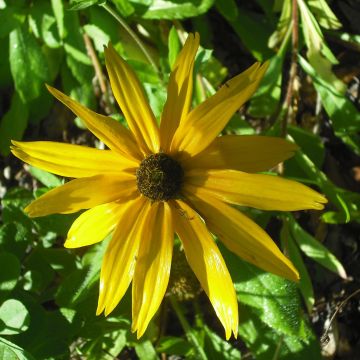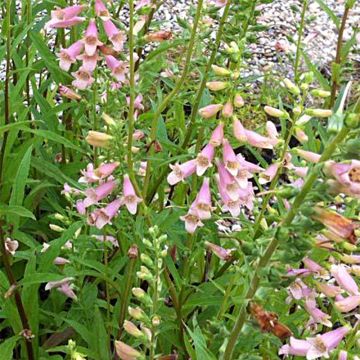

Helianthus decapetalus Flore Plenus


Helianthus decapetalus Flore Plenus
Helianthus decapetalus Flore Plenus
Helianthus decapetalus Plenus
Thin-leaved sunflower, Forest sunflower, Ten-petal sunflower
I don't remember if I ordered it in late '23 or early '24, but somewhere around that time. The first year, it got nibbled by some voracious slug and I only saved it by moving it. It rewarded me with two modest flowers at the end of the season but didn't exceed 30 cm in height. In the autumn, I questioned its future prospects. Nevertheless, I found it a new spot, making it clear that the second year would be its last chance. Good thing I did! In 2025, it's superb, a bit over a meter tall with flowers proportionate to the size of the young plant, and above all, a color I adore—golden yellow, exactly matching what you see at the top of this product page. Plus, its stems have a lovely purple hue that contrasts beautifully with the flowers. In a word, it has everything going for it. Until now, I only grew "Lemon Queen" in this family, also very beautiful but too tall for modest flowerbeds where it doesn't hesitate to cast shade on the hardy geraniums, verbenas, and other potted dahlias. I learned that this year the hard way; nothing serious, it will change places in autumn. Plenus, on the other hand, integrates perfectly into already established plant groups and doesn't show off. In short, a very good recruit for informal country gardens alongside other "all-terrain" plants in its genus.
Philippe 87, 06/08/2025
Special offer!
Receive a €20 voucher for any order over €90 (excluding delivery costs, credit notes, and plastic-free options)!
1- Add your favorite plants to your cart.
2- Once you have reached €90, confirm your order (you can even choose the delivery date!).
3- As soon as your order is shipped, you will receive an email containing your voucher code, valid for 3 months (90 days).
Your voucher is unique and can only be used once, for any order with a minimum value of €20, excluding delivery costs.
Can be combined with other current offers, non-divisible and non-refundable.
Home or relay delivery (depending on size and destination)
Schedule delivery date,
and select date in basket
This plant carries a 12 months recovery warranty
More information
We guarantee the quality of our plants for a full growing cycle, and will replace at our expense any plant that fails to recover under normal climatic and planting conditions.
Would this plant suit my garden?
Set up your Plantfit profile →
Description
Helianthus decapetalus 'Flore Plenus', a double variety of perennial sunflower with ten petals, is a non-invasive woody-based plant. It forms a tall and bushy clump, with sturdy stems that bloom from late summer until the first frost. Its flowers resemble golden yellow daisies with a darker rounded centre. This sunflower is the last smile of the garden, bringing much cheerfulness to the countryside borders and autumn foliage towards the end of the season.
Helianthus decapetalus belongs to the Asteraceae family, and the 'Flore Plenus' variety reaches 1.5 metres (5 feet) in height with a spread of 1 metre (3 feet) at the base. The overall appearance is a bouquet of sturdy stems, glabrous at the base, bristly and rough towards their ends, and branched. The flowering period spans from September to November. The heads appear in large numbers at the top of the stems, resembling fully-double and round daisies with a 5 to 8cm (2 to 3in) diameter, intense yellow colour and a slightly brown centre. The deciduous leaves are lanceolate to obovate, velvety underneath, and measure 10cm (4in) long. They are distributed all the way to the top of the stems.
The great interest of perennial sunflowers lies in their late flowering and excellent adaptability to heavy, clayey, and even limestone soils. Helianthus decapetalus 'Flore Plenus' is an excellent long-lasting perennial. Vigorous, it is perfect for the back of borders or mixed borders. It is a plant with a countryside look that blends well in slightly wild areas of the garden, alongside Cosmos, sainfoin, tall Scabious, and pendulous Carex, for example. Another idea for association, with equally easy plants: Vernonia noveboracensis, Eupatorium fistulosum, Andropogon virginicus, Muhlenbergia capillaris. Its tall stature allows it to be placed in front of shrubs (deciduous Euonymus, Spireas, Hydrangea quercifolia, Cotinus..), which will provide natural support while blending their autumn colours with its sunny flowering.
Perennial sunflowers have gained a bad reputation due to the wild species that were previously offered, which tended to invade the entire garden due to their long running rhizomes. The plants we offer today are non-running or have minimal spreading tendencies.
Report an error about the product description
Helianthus decapetalus Flore Plenus in pictures




Flowering
Foliage
Plant habit
Botanical data
Helianthus
decapetalus
Plenus
Asteraceae
Thin-leaved sunflower, Forest sunflower, Ten-petal sunflower
Cultivar or hybrid
Other Helianthus
View all →Planting and care
Plant Helianthus decapetalus 'Flore Plenus' in ordinary soil, even clayey or limestone, but fertile. Plant in a sunny location, sheltered from strong winds that could flatten the clump, yet sturdy. The plant does not need to be staked. Prune the clump after flowering to prevent seed formation, or in late winter to maintain a compact habit.
Planting period
Intended location
Care
-
, onOrder confirmed
Reply from on Promesse de fleurs
Similar products
Haven't found what you were looking for?
Hardiness is the lowest winter temperature a plant can endure without suffering serious damage or even dying. However, hardiness is affected by location (a sheltered area, such as a patio), protection (winter cover) and soil type (hardiness is improved by well-drained soil).

Photo Sharing Terms & Conditions
In order to encourage gardeners to interact and share their experiences, Promesse de fleurs offers various media enabling content to be uploaded onto its Site - in particular via the ‘Photo sharing’ module.
The User agrees to refrain from:
- Posting any content that is illegal, prejudicial, insulting, racist, inciteful to hatred, revisionist, contrary to public decency, that infringes on privacy or on the privacy rights of third parties, in particular the publicity rights of persons and goods, intellectual property rights, or the right to privacy.
- Submitting content on behalf of a third party;
- Impersonate the identity of a third party and/or publish any personal information about a third party;
In general, the User undertakes to refrain from any unethical behaviour.
All Content (in particular text, comments, files, images, photos, videos, creative works, etc.), which may be subject to property or intellectual property rights, image or other private rights, shall remain the property of the User, subject to the limited rights granted by the terms of the licence granted by Promesse de fleurs as stated below. Users are at liberty to publish or not to publish such Content on the Site, notably via the ‘Photo Sharing’ facility, and accept that this Content shall be made public and freely accessible, notably on the Internet.
Users further acknowledge, undertake to have ,and guarantee that they hold all necessary rights and permissions to publish such material on the Site, in particular with regard to the legislation in force pertaining to any privacy, property, intellectual property, image, or contractual rights, or rights of any other nature. By publishing such Content on the Site, Users acknowledge accepting full liability as publishers of the Content within the meaning of the law, and grant Promesse de fleurs, free of charge, an inclusive, worldwide licence for the said Content for the entire duration of its publication, including all reproduction, representation, up/downloading, displaying, performing, transmission, and storage rights.
Users also grant permission for their name to be linked to the Content and accept that this link may not always be made available.
By engaging in posting material, Users consent to their Content becoming automatically accessible on the Internet, in particular on other sites and/or blogs and/or web pages of the Promesse de fleurs site, including in particular social pages and the Promesse de fleurs catalogue.
Users may secure the removal of entrusted content free of charge by issuing a simple request via our contact form.
The flowering period indicated on our website applies to countries and regions located in USDA zone 8 (France, the United Kingdom, Ireland, the Netherlands, etc.)
It will vary according to where you live:
- In zones 9 to 10 (Italy, Spain, Greece, etc.), flowering will occur about 2 to 4 weeks earlier.
- In zones 6 to 7 (Germany, Poland, Slovenia, and lower mountainous regions), flowering will be delayed by 2 to 3 weeks.
- In zone 5 (Central Europe, Scandinavia), blooming will be delayed by 3 to 5 weeks.
In temperate climates, pruning of spring-flowering shrubs (forsythia, spireas, etc.) should be done just after flowering.
Pruning of summer-flowering shrubs (Indian Lilac, Perovskia, etc.) can be done in winter or spring.
In cold regions as well as with frost-sensitive plants, avoid pruning too early when severe frosts may still occur.
The planting period indicated on our website applies to countries and regions located in USDA zone 8 (France, United Kingdom, Ireland, Netherlands).
It will vary according to where you live:
- In Mediterranean zones (Marseille, Madrid, Milan, etc.), autumn and winter are the best planting periods.
- In continental zones (Strasbourg, Munich, Vienna, etc.), delay planting by 2 to 3 weeks in spring and bring it forward by 2 to 4 weeks in autumn.
- In mountainous regions (the Alps, Pyrenees, Carpathians, etc.), it is best to plant in late spring (May-June) or late summer (August-September).
The harvesting period indicated on our website applies to countries and regions in USDA zone 8 (France, England, Ireland, the Netherlands).
In colder areas (Scandinavia, Poland, Austria...) fruit and vegetable harvests are likely to be delayed by 3-4 weeks.
In warmer areas (Italy, Spain, Greece, etc.), harvesting will probably take place earlier, depending on weather conditions.
The sowing periods indicated on our website apply to countries and regions within USDA Zone 8 (France, UK, Ireland, Netherlands).
In colder areas (Scandinavia, Poland, Austria...), delay any outdoor sowing by 3-4 weeks, or sow under glass.
In warmer climes (Italy, Spain, Greece, etc.), bring outdoor sowing forward by a few weeks.















































